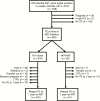Impact of Antiretroviral Therapy on Liver Fibrosis Among Human Immunodeficiency Virus-Infected Adults With and Without HBV Coinfection in Zambia
- PMID: 28158504
- PMCID: PMC5411400
- DOI: 10.1093/cid/cix122
Impact of Antiretroviral Therapy on Liver Fibrosis Among Human Immunodeficiency Virus-Infected Adults With and Without HBV Coinfection in Zambia
Erratum in
-
Erratum.Clin Infect Dis. 2017 Oct 15;65(8):1431-1433. doi: 10.1093/cid/cix563. Clin Infect Dis. 2017. PMID: 29017252 Free PMC article. No abstract available.
Abstract
Background: We investigated changes in hepatic fibrosis, based on transient elastography (TE), among human immunodeficiency virus (HIV)-infected patients with and without hepatitis B virus (HBV) coinfection on antiretroviral therapy (ART) in Zambia.
Methods: Patients' liver stiffness measurements (LSM; kiloPascals [kPa]) at ART initiation were categorized as no or minimal fibrosis (equivalent to Metavir F0-F1), significant fibrosis (F2-F3), and cirrhosis (F4). TE was repeated following 1 year of ART. Stratified by HBV coinfection status (hepatitis B surface antigen positive at baseline), we described LSM change and the proportion with an increase/decrease in fibrosis category. Using multivariable logistic regression, we assessed correlates of significant fibrosis/cirrhosis at 1 year on ART.
Results: Among 463 patients analyzed (61 with HBV coinfection), median age was 35 years, 53.7% were women, and median baseline CD4+ count was 240 cells/mm3. Nearly all (97.6%) patients received tenofovir disoproxil fumarate-containing ART, in line with nationally recommended first-line treatment. The median LSM change was -0.70 kPa (95% confidence interval, -3.0 to +1.7) and was similar with and without HBV coinfection. Significant fibrosis/cirrhosis decreased in frequency from 14.0% to 6.7% (P < .001). Increased age, male sex, and HBV coinfection predicted significant fibrosis/cirrhosis at 1 year (all P < .05).
Conclusion: The percentage of HIV-infected Zambian adults with elevated liver stiffness suggestive of significant fibrosis/cirrhosis decreased following ART initiation-regardless of HBV status. This suggests that HIV infection plays a role in liver inflammation. HBV-coinfected patients were more likely to have significant fibrosis/cirrhosis at 1 year on ART.
Clinical trials registration: NCT02060162.
Keywords: Africa; HIV/AIDS; hepatitis B virus; liver fibrosis; transient elastography..
© The Author 2017. Published by Oxford University Press for the Infectious Diseases Society of America. All rights reserved. For permissions, e-mail: journals.permissions@oup.com.
Figures



References
-
- Data Collection on Adverse Events of Anti-HIV Drugs Study Group. Liver-related deaths in persons infected with the human immunodeficiency virus: the D: A: D study. Arch Intern Med 2006; 166:1632. - PubMed
-
- Grant J, Agbaji O, Muhammad M, et al. Long-term changes in liver fibrosis in HIV and HIV/HBV infected Nigerians on ART. Boston, MA: Conference on Retroviruses and Opportunistic Infections, IAS-USA, 2016.
-
- Tuyama AC, Hong F, Saiman Y, et al. Human immunodeficiency virus (HIV)-1 infects human hepatic stellate cells and promotes collagen I and monocyte chemoattractant protein-1 expression: implications for the pathogenesis of HIV/hepatitis C virus-induced liver fibrosis. Hepatology 2010; 52:612–22. - PMC - PubMed
MeSH terms
Substances
Associated data
Grants and funding
LinkOut - more resources
Full Text Sources
Other Literature Sources
Medical
Research Materials
Miscellaneous

